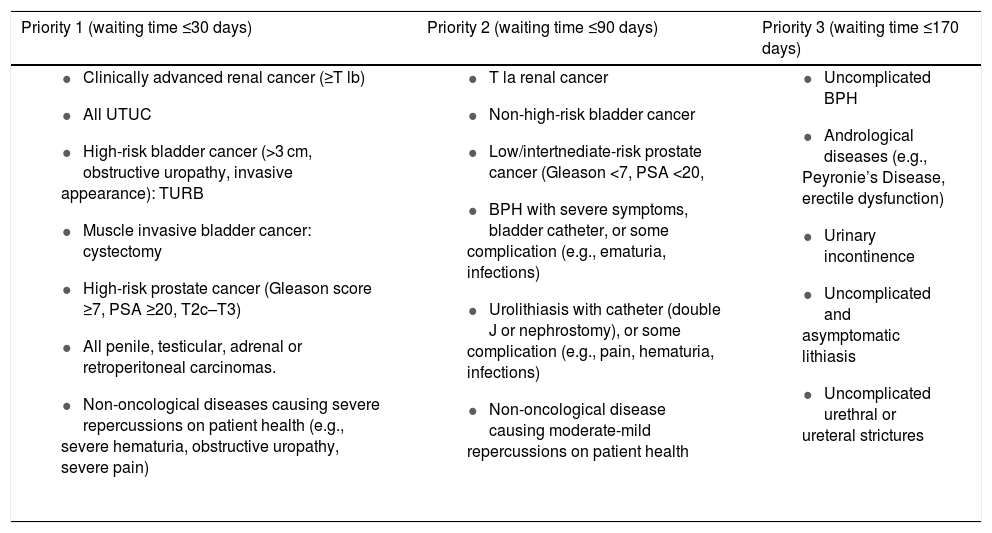The suspension of most elective surgeries during COVID-19 pandemic caused the lengthening of urology surgical waiting lists. The objective of this study is to evaluate the impact of COVID-19 pandemic on urology surgical waiting list in a high-volume hospital.
MethodsAn observational descriptive study was designed. All patients included in the urology surgical waiting list of our high-volume center on May 1st 2020 (46 days after the suspension of elective surgery) were analyzed. Baseline variables, priority on the waiting list, main urological disease, type of scheduled surgery, and waiting time were recorded. Other variables recorded were the presence of a urinary catheter, number of accesses to the emergency department, evidence of COVID-19 infection, number of deaths and their cause. The waiting time for each disease was compared with the time to surgery in 2019.
ResultsA total of 350 patients were included. The mean (SD) time on the waiting list was 97.33 (55.47) days. Priority 1 patients, who normally should undergo surgery within 30 days, were on the waiting list for a mean (SD) time of 60.51 (20.14) days. They were mainly patients with ureteral lithiasis (25.6%), high-risk or muscle-invasive bladder cancer (20.9%) and high-risk prostate cancer (13.9%). The mean waiting time had already significantly exceeded the mean time to surgery in 2019 for radical cystectomy (p = 0.04) and URS (p = 0.003).
ConclusionsThe suspension of most elective surgeries due to COVID-19 had a significant impact on urology surgical waiting list of our high-volume center, especially in priority 1 group.
La suspensión de la mayoría de las cirugías electivas durante la pandemia por COVID-19 ha aumentado las listas de espera de cirugía urológica. El objetivo de este estudio es evaluar el impacto de la pandemia COVID-19 en la lista de espera de cirugía urológica en un hospital de alto volumen.
MétodosSe diseñó un estudio descriptivo observacional. Se analizaron todos los pacientes incluidos en la lista de espera de cirugía urológica de nuestro centro de alto volumen el 1 de mayo de 2020 (46 días después de la suspensión de la cirugía electiva). Se registraron las características basales, prioridad en la lista de espera, enfermedad urológica principal, tipo de cirugía programada y tiempo de espera. Otras variables registradas fueron la presencia de catéter urinario, el número de visitas al servicio de urgencias, evidencia de infección por COVID-19, el número de muertes y su causa. El tiempo de espera de cada enfermedad se comparó con el tiempo de espera para la cirugía en 2019.
ResultadosUn total de 350 pacientes fueron incluidos en el estudio. El tiempo medio (DE) en la lista de espera fue de 97,33 (55,47) días. Los pacientes de prioridad 1, que normalmente deben ser operados en un plazo de 30 días, estuvieron en la lista de espera por un tiempo medio de 60,51 (20,14) días. Eran principalmente pacientes con litiasis ureteral (25,6%), cáncer de vejiga de alto riesgo o músculo-invasivo (20,9%) y cáncer de próstata de alto riesgo (13,9%). El tiempo medio de espera superaba significativamente el tiempo medio (DE) de espera para cistectomía radical (p = 0,04) y URS (p = 0,003) en 2019.
ConclusionesLa suspensión de la mayoría de las cirugías electivas debido a la pandemia por COVID-19 tuvo un impacto significativo en la lista de espera de cirugía urológica de nuestro centro de alto volumen, especialmente en el grupo de prioridad 1.










